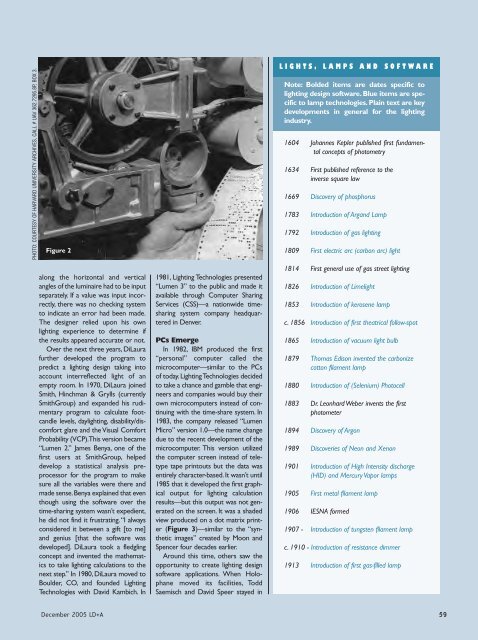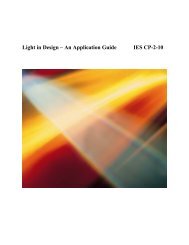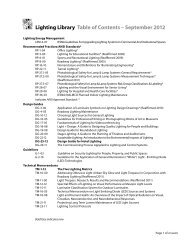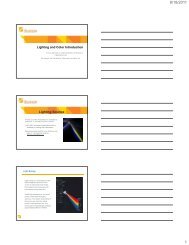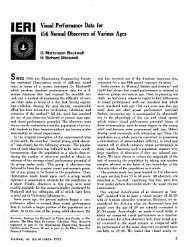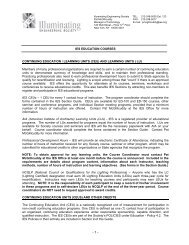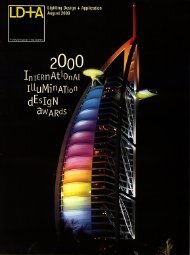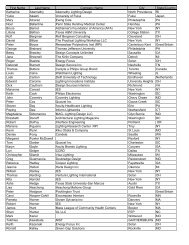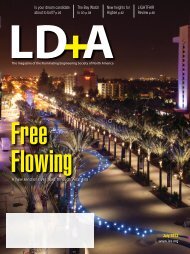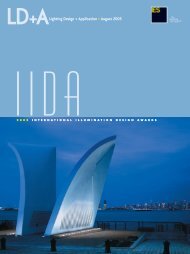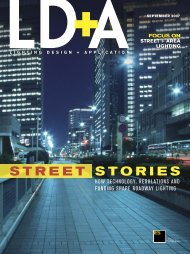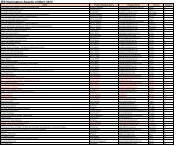light products - Illuminating Engineering Society
light products - Illuminating Engineering Society
light products - Illuminating Engineering Society
Create successful ePaper yourself
Turn your PDF publications into a flip-book with our unique Google optimized e-Paper software.
PHOTO: COURTESY OF HARVARD UNIVERSITY ARCHIVES, CALL # UAV 362.7295.8P, BOX 3.<br />
Figure 2<br />
LIGHTS,<br />
LAMPS AND SOFTWARE<br />
Note: Bolded items are dates specific to<br />
<strong>light</strong>ing design software. Blue items are specific<br />
to lamp technologies. Plain text are key<br />
developments in general for the <strong>light</strong>ing<br />
industry.<br />
1604 Johannes Kepler published first fundamental<br />
concepts of photometry<br />
1634 First published reference to the<br />
inverse square law<br />
1669 Discovery of phosphorus<br />
1783 Introduction of Argand Lamp<br />
1792 Introduction of gas <strong>light</strong>ing<br />
1809 First electric arc (carbon arc) <strong>light</strong><br />
along the horizontal and vertical<br />
angles of the luminaire had to be input<br />
separately. If a value was input incorrectly,<br />
there was no checking system<br />
to indicate an error had been made.<br />
The designer relied upon his own<br />
<strong>light</strong>ing experience to determine if<br />
the results appeared accurate or not.<br />
Over the next three years, DiLaura<br />
further developed the program to<br />
predict a <strong>light</strong>ing design taking into<br />
account interreflected <strong>light</strong> of an<br />
empty room. In 1970, DiLaura joined<br />
Smith, Hinchman & Grylls (currently<br />
SmithGroup) and expanded his rudimentary<br />
program to calculate footcandle<br />
levels, day<strong>light</strong>ing, disability/discomfort<br />
glare and the Visual Comfort<br />
Probability (VCP).This version became<br />
“Lumen 2.” James Benya, one of the<br />
first users at SmithGroup, helped<br />
develop a statistical analysis preprocessor<br />
for the program to make<br />
sure all the variables were there and<br />
made sense.Benya explained that even<br />
though using the software over the<br />
time-sharing system wasn’t expedient,<br />
he did not find it frustrating.“I always<br />
considered it between a gift [to me]<br />
and genius [that the software was<br />
developed]. DiLaura took a fledgling<br />
concept and invented the mathematics<br />
to take <strong>light</strong>ing calculations to the<br />
next step.” In 1980, DiLaura moved to<br />
Boulder, CO, and founded Lighting<br />
Technologies with David Kambich. In<br />
1981, Lighting Technologies presented<br />
“Lumen 3” to the public and made it<br />
available through Computer Sharing<br />
Services (CSS)—a nationwide timesharing<br />
system company headquartered<br />
in Denver.<br />
PCs Emerge<br />
In 1982, IBM produced the first<br />
“personal” computer called the<br />
microcomputer—similar to the PCs<br />
of today. Lighting Technologies decided<br />
to take a chance and gamble that engineers<br />
and companies would buy their<br />
own microcomputers instead of continuing<br />
with the time-share system. In<br />
1983, the company released “Lumen<br />
Micro” version 1.0—the name change<br />
due to the recent development of the<br />
microcomputer. This version utilized<br />
the computer screen instead of teletype<br />
tape printouts but the data was<br />
entirely character-based. It wasn’t until<br />
1985 that it developed the first graphical<br />
output for <strong>light</strong>ing calculation<br />
results—but this output was not generated<br />
on the screen. It was a shaded<br />
view produced on a dot matrix printer<br />
(Figure 3)—similar to the “synthetic<br />
images” created by Moon and<br />
Spencer four decades earlier.<br />
Around this time, others saw the<br />
opportunity to create <strong>light</strong>ing design<br />
software applications. When Holophane<br />
moved its facilities, Todd<br />
Saemisch and David Speer stayed in<br />
1814 First general use of gas street <strong>light</strong>ing<br />
1826 Introduction of Lime<strong>light</strong><br />
1853 Introduction of kerosene lamp<br />
c. 1856 Introduction of first theatrical follow-spot<br />
1865 Introduction of vacuum <strong>light</strong> bulb<br />
1879 Thomas Edison invented the carbonize<br />
cotton filament lamp<br />
1880 Introduction of (Selenium) Photocell<br />
1883 Dr. Leonhard Weber invents the first<br />
photometer<br />
1894 Discovery of Argon<br />
1989 Discoveries of Neon and Xenon<br />
1901 Introduction of High Intensity discharge<br />
(HID) and Mercury Vapor lamps<br />
1905 First metal filament lamp<br />
1906 IESNA formed<br />
1907 - Introduction of tungsten filament lamp<br />
c. 1910 - Introduction of resistance dimmer<br />
1913 Introduction of first gas-filled lamp<br />
December 2005 LD+A 59


